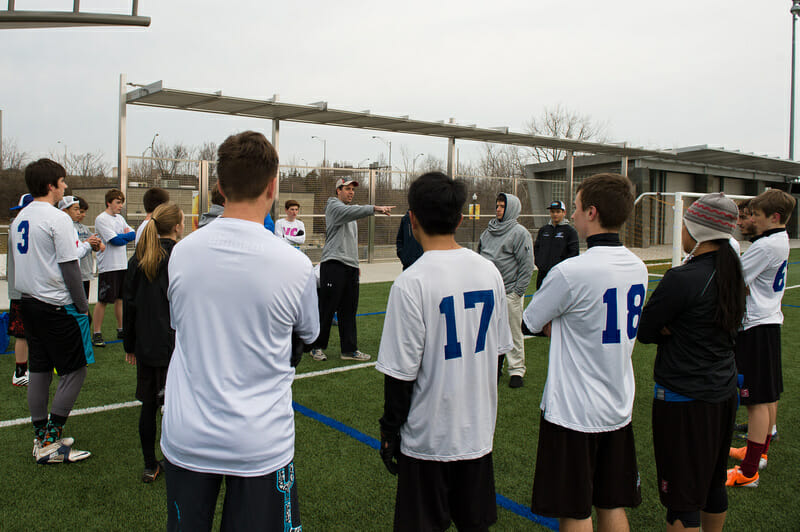Get what you need to build smart practices from the best of the Tuesday Tips archives.
November 6, 2018 by Ultiworld in Opinion with 0 comments

This article is presented by Spin Ultimate; all opinions are those of the author. Please support the brands that make Ultiworld possible and shop at Spin Ultimate!
Good teams plan great practices. Great teams have excellent practices, consistently.
Building excellent practices is tough. Teams need frameworks for building balanced practices that don’t try to cover too many topics in one afternoon or force players to overexert themselves constantly. They need pod workouts that provide supplemental work for players, so practice time isn’t wasted on skills that are easily covered in small groups. And they need a good focus—a skill or skillset that can be broken down into digestible concepts and retained.
Our Tuesday Tips authors have covered numerous ideas to help you build your game and level up your team. This week, we dug into the archives to build you a practice starter kit: how to think about your drills, build your pod workouts, and teach basic concepts like throwing, marking, and laying out.
Call it a Tuesday Tips Practice Starter Kit.
Balancing Push Drills Vs. Perfect Drills And The Forgiveness Factory
You shouldn’t spend every practice striving for perfection. Certain drills should allow—or even encourage—players to make mistakes in order to learn new skills. Others should encourage attention to detail and perfection. So how do you decide which framework you’re applying when?
Ontario ultimate veteran Jamie Millage has sorted drills into Push and Perfect categories. He offers guidance on how to build a practice that balances these concepts so players aren’t trying to perfect a skill the first time they learn it, or making careless mistakes when they need to focus on the details. Plus, he adds a bonus section on how to coach or guide those teammates who are uncomfortable making mistakes in a practice setting.
Building The Perfect Pod Workout
Not all pod workouts are created equal. Small groups are particularly flexible for handling those outside-of-practice musts, like focused throwing; speed and agility drills; track and hill workouts; and even games like 3-on-3 mini.
But no matter what you’re covering, there’s a smart way to structure these critical small group practices. Take it from Strive & Uplift coach and Seattle Mixtape veteran, Bert Abbott. Check out her advice on how to set an intention for each pod workout and how to organize the different sections in a smart way that’ll build skills and prevent injuries.
Get Your Throws In Shape
Immediately after she makes a catch, an ultimate player has a job to do: make good next throw.1 What makes her next throw effective? Here’s the criteria, according to Harvard Red Line alumnus and ultimate coach Dave Lipson. Her throw:
-
Is as easy as possible to catch.
-
Lets the receiver catch the disc in a favorable or advantageous position.
-
Minimizes any defender’s opportunity to get a block.
Read Lipson’s piece to build a better idea of how to coach smart, effective throwing.
How To Take Your Mark To Next Level
Using video to illustrate a skill (individual or team) is still an underrated, underused method of coaching, especially when considering how to teach defense. So much of denying a space to a cutter or a thrower relies on understanding the shape of the field and your related body position. Where do you start if you’re a team leader, but you’ve never played under a defensive specialist?
You start with great tape and analysis.2 That’s what AJ Klopfenstein offers up in his marking breakdown, using video clips to carefully show the concepts that distinguish decent marks from excellent ones. Watch the clips to build your vocabulary on how to approach the mark, coordinate your team-wide strategy, and talk about adjusting to the offense’s game plan.
How To Lay Out
There’s more to laying out than throwing caution to the wind and hoping for the best—and not all your possession-saving bids or big-time blocks need to end with bruises or a stoppage. Beyond getting comfortable getting dirty, teams working on layouts should have a plan for talking through how to see the opportunity and how to complete ultimate’s fabled feat of athleticism safely.3
Indispensable Tuesday Tips columnist Alex Rummelhart has your guide to laying out. So make sure to think through your upcoming practice plans and secure some time to figure out how to hit the deck smartly and in style.
Unless she’s just scored, in which case she shouldn’t miss her kick spike. ↩
Editor’s note: click here to get access to great tape. ↩
Editor’s note: none of the advice is, “Land on your shoulder first with your eyes closed.” ↩